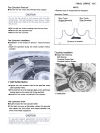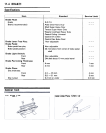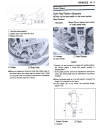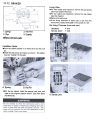
BRAKES 11-5
Brake Fluid
Brake Fluid Requirement:
Recommended fluids are given in the table below. If
none of the recommended brake fluids are available, use
extra heavy-duty brake fluid only from a container marked
D.O.T.3.
Recommended Disc Brake Fluid
Fluid Level Inspection
In accordance with the Periodic Maintenance Chart,
inspect the brake fluid level in the front and rear brake fluid
reservoir.
.Check the brake fluid level in the reservoir.
NOTE
0 Hold the reservoir horizontal when checking brake fluid
level.
*The fluid level must be kept above the lower level lines.
If the fluid level is lower than the lower level line, fill the
reservoir to the upper level line of the reservoir.
Changing Brake Fluid:
.Remove the rubber cap on the bleed valve.
.Attach a clear plastic hose to the bleed valve on the
caliper, and run the other end of the hose into a
container.
.Open the bleed valve (counterclockwise to open), and
pump the brake lever or pedal until all the fluid is drained
from the line.
.Close the bleed valve.
.Remove the reservoir cap.
.Fill the reservoir with fresh brake fluid.
.Install the reservoir cap.
.Open the bleed valve, apply the brake by the brake lever
or pedal, close the valve with the brake held applied, and
then quickly release the lever or pedal. Repeat this
operation until the brake line is filled and fluid starts
coming out of the plastic hose.
NOTE
OReplenish the fluid in the reservoir as often as necessary
to keep it from running completely out.
.Bleed the air from the lines ( continue with Bleeding the
Brake).
B. Upper Level Line
Filling up the Brake Line
A. Lower Level Line
Brake Fluid Change
In accordance with the Periodic Maintenance Chart,
change the brake fluid. The brake fluid should also be
changed if it becomes contaminated with dirt or water.


















